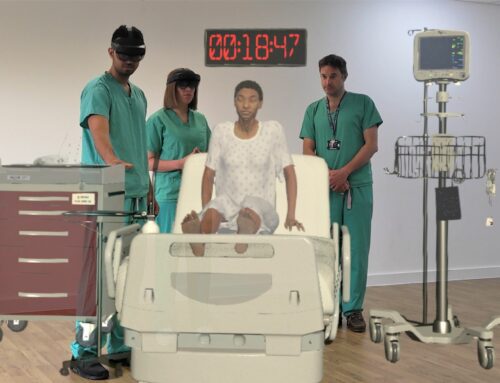By Brad Samson, Vice President of Investor Relations, Zepp Health
In healthcare circles, smart wearables seem to get treated like Rodney Dangerfield. They do not get any respect. But smart health devices provide a unique and critical bridge between the healthcare system and consumers. And that is true not only in the U.S. healthcare system, but in healthcare systems around the globe. As the use of smart watches, fitness trackers, rings, ear buds and other wearables continue to increase, and the results of improving health increase by mining the mountains of data collected, wearables are getting recognized for their important role in the healthcare system.
The Data Bridge
Wearables provide a critical conduit for collecting usable health data. In the past, broad-based attempts at healthcare system improvements were driven primarily by utilizing insurance claims data. In the mid 2000s, passage of the Patient Protection and Affordable Care Act (PPACA) in 2012 created financial incentives for care providers to implement electronic health records (EHRs), and many new applications and services have been created to gain insights from those new clinical data stores. More recently, with increasing adoption of smart wearable health devices, enormous data sets of incredibly detailed individuals’ health information have been collected, which is just beginning to be analyzed.
Each of these types of data has their own strengths and weaknesses. For example, one commonly questioned weakness of smart health device data is whether it is ‘clinical grade.’ While that can be debated, what is true is that data quality is improving rapidly as smart device sensors and algorithms improve with use, and with the new applications of artificial intelligence (AI). Just like any technology, over time it gets better and better.
In addition, one of the key strengths of smart wearable data is its frequency. If you own a smartwatch or fitness band, you know that your device is collecting a tremendous amount of granular data on a long, nearly continuous time scale. At Zepp Health alone, we have half a dozen joint research operations underway with unaffiliated universities and laboratories, looking at data to improve sleep, detect heart problems, and even detect COVID-19.
Obviously, the long-term play to connect all these data sets to derive healthcare information and potential improvements for individuals and populations.
We have barely scratched the surface of the data to be mined. In the U.S., which is arguably the most mature wearables market, about one in five Americans wear a smart health device, according to a Pew Research survey.1 As device prices decline, demand for smart wearable devices is growing rapidly. For example, a smart wearable device that includes a robust array of sensors and algorithms (including heart rate), and a nice complement of smart features can be purchased for less than U.S. $50 today.
Wearables have a long growth curve ahead, watched and analyzed closely by International Data Corporation (IDC), whose latest report forecasts double-digit growth through 2024.2
The Consumer Engagement Bridge
Beyond collecting data, wearables serve as a powerful tool for consumer engagement with health and with the healthcare system. Sales of smart wearables are growing rapidly around the world as people are increasingly focusing on health and fitness. Yet, there remain many consumers who don’t want to engage with their health or with the healthcare system, as evidenced by obesity rates that continue to climb.
Here is where wearables perform their second, and perhaps even more important function in healthcare, to engage consumers. Its importance becomes more evident when you drill down to understand what drives consumer engagement, and the distinction from consumer activation.
It is fashionable right now in the healthcare technology world to talk about “consumer activation” instead of ‘consumer engagement.’ Consumer activation means getting a consumer to act, to do something, such as selecting a health plan, or opting-in to a smoking cessation program.
But the key distinction is that consumer activation is most often driven by healthcare institutional programs, such as insurers, care providers and employers. In other words, top-down driven consumer interaction. There are two problems with top-down approaches.
First, many of these programs are built around the assumption that people want to engage. For example, look at the consumer engagement activities hospitals put together, with elaborate patient portals, large stores of condition and treatment information, and extensive marketing of their services and clinical staff. But that is predominantly a ‘build-it-and-they-will-come strategy, and unless a consumer is actively seeking care information, they’re not going to visit that site.
As one key data point, a 2018 McKinsey study of U.S. healthcare consumers found that half are either completely disconnected from thinking about their health, or only engage when necessary.3
An August 2019 Harvard Business Review article highlighted data showing that although 97% of large U.S. companies offer Employee Assistance Plans, only 7% of people use them.4
Whether it’s an employer-sponsored wellness program or an insurer engagement platform (e.g. Rally Health), top-down ‘activation’ programs are hampered by employees’ worries about who sees their data, whether their health data could impact their employment or insurance, data security and privacy, and being told what to do. A 2020 Mercer Marsh/Oliver Wyman study of workforce digital health attitudes proposed a future model of integrated 24-hour monitored employee healthcare, which more than one-third of respondents found ‘disturbing.’5
Although consumers always rate doctors as the entity they most trust with their health information, a 2018 joint study by four American universities found that 81% of Americans lie to their doctor about their exercise, drinking, eating and other habits.6 Apparently, we like our privacy.
So, then, why are sales of smart health wearables growing so rapidly?
Aspiration. That is the difference between activation and engagement. Activation is top-down, B-to-C, from the industry to the consumer, trying to force the issue. In contrast, consumer engagement is driven by peoples’ desire to improve their health – on their own terms, at their own speed, and with the level of privacy they determine.
The 2020 Mercer Marsh/Oliver Wyman Health On-Demand report also found that more than 40% of workers think that wearable devices are highly valuable or extremely valuable for managing their health. There are plenty of studies that show people in all cultures are interested in health improvement. Wearable devices, whether a smart watch or fitness tracker represent an easy, non-threatening, low-commitment first step for many people.
Some people go all-in. Some people start and then give up. Many people wax and wane in their interest in tracking their health. But all of these people have chosen to become engaged, and that makes a significant difference in their attitude and approach to their health and to health administrators compared to forced ‘activation’.
In its 2020 survey of health care consumers, Deloitte found that of those tracking their health with a device, 77% said that it had at least moderately changed their behavior.7
The smart watch phenomenon has tapped into another aspirational goal, fashion. Smart watches have taken over a significant share of traditional fashion watch sales. Aside from demonstrating their currency with fashion trends, people find many of the basic smart watch functions addictive, such as all the basic call, text and email notifications.
Together, these fitness and fashion aspirational drivers are creating the continuing demand for smart wearable devices. Even if you bought a smart watch more for fashion than health, it’s hard not to start paying attention to all those health data screens as you swipe through watch screens before bed. What does that heart data mean? How well am I sleeping? For many people, we believe these non-health initial purchase criteria make a successful introduction to health awareness for a portion of this group.
Significant Global Opportunity Remains
As long as these aspirational drivers exist, smart wearables will have an important role in connecting consumers to their health and to the health care systems.
The U.S. is arguably the most mature market for smart wearable devices. The 2020 Deloitte survey found that 42% of consumers are measuring their fitness and health, and 28% are monitoring specific health issues.8
Health and fitness awareness and interest are on the rise globally. In many cases, that is happening hand-in-hand with rising incomes, and obesity. China’s obesity rate has tripled in a decade.9 India’s rate is similar. Smart wearable markets are much less mature in other parts of the world, representing significant growth opportunities.
IDC projects that wearable device shipments will increase to 637 million globally in 2024. Tremendous growth remains for the industry. And it will not all be the Apple watch. But that’s another story.
About the author
Brad Samson is the Vice President of Investor Relations for Zepp Health, Inc. Brad has worked in many facets of the healthcare industry over the last 18 years, including payer systems technology, wellness programs, hospital systems and wearables. In addition to running investor relations and communications, he has lobbied for healthcare policy issues on Capitol Hill, fixed a key part of the Affordable Care Act that facilitated wellness program investments, and co-wrote a book on the U.S. healthcare system.
Footnotes
1 About one-in-five Americans use a smart watch or fitness tracker, Pew Research Center, 1/9/20
2 Worldwide Wearables Market Forecast to Maintain Double-Digit Growth in 2020 and Through 2024, According to IDC, International Data Corporation, 9/25/20
3 Healthcare Consumerism Today: Accelerating the Consumer Experience, McKinsey & Company, 4/19
4 What Wellness Programs Don’t Do for Workers, Harvard Business Review, 8/19
5 Health On Demand Global Report, Mercer Marsh/Oliver Wyman, 2/20
6 Up to 81% of patients lie to their doctors—and there’s one big reason why, Advisory Board, 12/10/18
7,8 2020 Survey of US Health Care Consumers, Deloitte, 8/13/20
9 Chinese Center for Disease Control and Prevention, 2014
Key Resources and Suggested Reading
Mercer Marsh/Oliver Wyman Health On Demand Global Report, February, 2020
Worldwide Wearables Market Forecast to Maintain Double-Digit Growth in 2020 and Through 2024, According to IDC, IDC, 9/25/20
https://www.idc.com/getdoc.jsp?containerId=prUS46885820
Accenture Digital Health Consumer Survey 2020
What Wellness Programs Don’t Do for Workers, Harvard Business Review, Aug., 2019
https://hbr.org/2019/08/what-wellness-programs-dont-do-for-workers
The Mayo Clinic, lululemon, Peloton and Google: Retail Needs To Study Healthcare’s Transformation Playbook, Forbes 9/11/20
Wearable technology in healthcare: What are the key macroeconomic themes?, GlobalData Thematic Research, 13th November 2019 (Last Updated July 22nd, 2020
https://www.verdict.co.uk/wearable-technology-healthcare-macroeconomic-themes/
DO WELLNESS PROGRAMS WORK? NOT IF THEY MAKE THESE MISTAKES, Dr. Steve Aldana
Wellsteps Blog, updated July 6, 2020
https://www.wellsteps.com/blog/2020/01/02/do-wellness-programs-work/
Up to 81% of patients lie to their doctors—and there’s one big reason why, Advisory Board, 12/10/18
Deloitte 2020 Survey of US Health Care Consumers, 8/13/20
https://www2.deloitte.com/us/en/insights/industry/health-care/consumer-health-trends.html
Exciting Innovations Push the Boundaries of Healthcare’s Diagnostic Abilities, MarketsandMarkets, 9/22/20
About one-in-five Americans use a smart watch or fitness tracker, Pew Research Center, 1/9/20
Consumers Catch the Exercise Bug, NutraIngredients, October 2020
Support for telehealth and mobile health monitoring rises since COVID, study says, University of Alabama Huntsville, 8/13/2020
Patient engagement 2.0: How life sciences companies can take patient engagement to the next level, Deloitte Review, July 2020
file:///Users/bradleysamson/Downloads/DI_DR27-Patient-engagement.pdf
Healthcare consumerism today: Accelerating the consumer experience, McKinsey & Company, April 2019
Statista Research, Attitudes towards health and the health system in China 2017
https://www.statista.com/forecasts/822323/attitudes-towards-health-and-the-health-system-in-china












